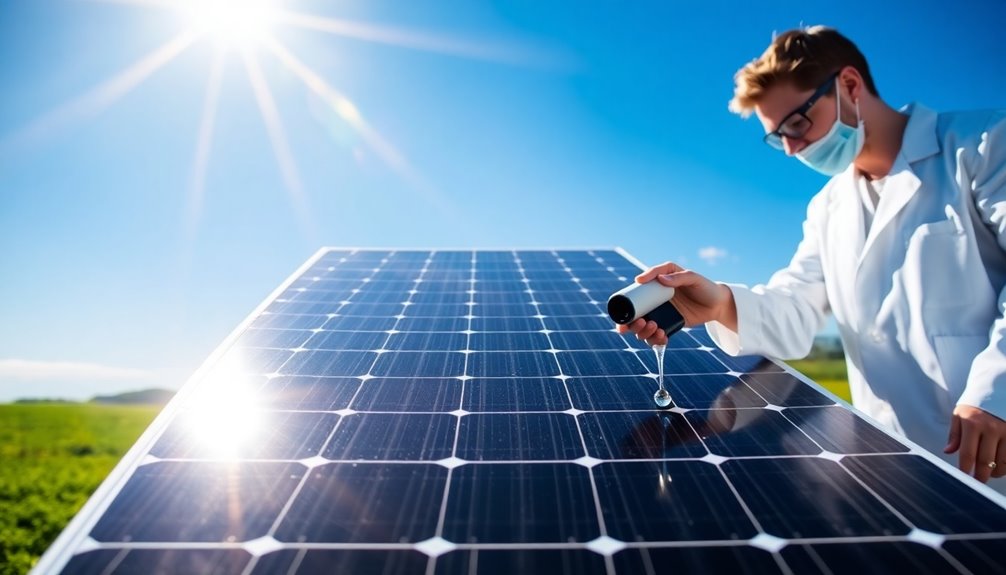When investigating PFAS presence in solar photovoltaic modules, you'll find that while some components may use fluoropolymers for durability, most solar panels primarily feature standard materials like silicon-based coatings. The use of PFAS isn't widespread in these technologies, though some self-cleaning coatings might contain them. As environmental regulations evolve, manufacturers are being urged to disclose any PFAS content. There's ongoing research into safer alternatives, which you'll discover as you explore more.
Key Takeaways
- PFAS are not commonly used in solar photovoltaic modules, with most panels utilizing silicon-based coatings and standard materials.
- Some self-cleaning coatings in solar panels may contain PFAS, raising concerns about environmental impact.
- State health departments are actively seeking manufacturer disclosures regarding PFAS content in solar panel components.
- PFAS contribute to enhanced durability and performance in some applications, but pose significant long-term ecological risks.
- Ongoing innovation aims to develop safer alternatives to PFAS for various applications, including renewable technologies.

As concerns about environmental pollution rise, it's crucial to understand the role of Per- and Polyfluoroalkyl Substances (PFAS) in solar photovoltaic modules. PFAS, often dubbed "forever chemicals," are known for their persistence in the environment and are commonly used for their water-repellent properties.
While their durability makes them appealing in various industries, including firefighting foams and non-stick coatings, their environmental impact raises significant concerns. PFAS don't easily break down, accumulating in ecosystems, affecting wildlife, and posing potential health risks to humans.
The durability of PFAS makes them valuable, yet their persistence in the environment poses serious ecological and health risks.
In the realm of solar energy, fluoropolymers—which can include PFAS—enhance the durability of components like front and back sheet films in solar panels. However, it's essential to note that specific PFAS usage in photovoltaic modules isn't prevalent. Concerns over PFAS in solar panels have prompted state health departments to seek disclosures from manufacturers regarding their content.
Instead, most solar panels rely on standard materials such as silicon-based coatings and silicone polymers, which don't contain PFAS. While some self-cleaning coatings used in solar panels may contain PFAS, the primary construction materials generally do not, easing some concerns about their environmental footprint.
Despite the potential benefits of PFAS, such as reduced emissions and lower energy costs through enhanced energy efficiency in renewable technologies, regulatory efforts are underway globally to minimize their use due to health concerns.
Safer alternatives have been developed for many applications, providing viable options without the associated risks of PFAS.
Frequently Asked Questions
What Are PFAS and Why Are They a Concern?
PFAS, or per- and polyfluoroalkyl substances, are synthetic chemicals known for their resistance to water, oil, and heat.
They're used in a variety of products, but they pose significant health risks, including liver damage, immune system issues, and potential cancer links.
Their environmental persistence means they accumulate over time, raising concerns about long-term exposure.
As awareness grows, regulations are tightening to mitigate their impact on both human health and the environment.
How Are PFAS Tested in Solar Modules?
You'll find that PFAS testing in materials involves various sophisticated techniques.
Initially, you might look for total fluorine using methods like liquid chromatography/mass spectrometry (LC-MS/MS).
Then, you could employ non-targeted screening to analyze a wide range of substances. Mass spectrometry can provide rapid results, while sample preparation ensures accuracy.
Ultimately, the goal's to verify compliance with environmental safety standards, ensuring products meet regulatory requirements and are free from harmful substances.
What Are the Health Effects of PFAS Exposure?
Did you know that nearly 200,000 people in the U.S. live near PFAS-contaminated sites?
PFAS exposure can lead to serious health issues, including decreased fertility and increased cancer risks, particularly prostate and kidney cancers.
It also affects immune responses, making it harder for your body to fight infections.
Vulnerable groups, like pregnant women and infants, face heightened risks, emphasizing the need for awareness and preventive measures to protect your health.
Are There Regulations Regarding PFAS in Solar Energy Products?
Yes, there are regulations regarding PFAS in solar energy products.
You'll need to be aware of federal and state requirements. Companies must report PFAS use and comply with state bans, like those in Maine and Minnesota, which limit products containing PFAS.
The EPA mandates detailed reporting on PFAS substances used in your products, requiring you to gather information and submit reports by May 2025.
Compliance is crucial for maintaining your operations.
How Can I Dispose of Solar Panels Containing PFAS Safely?
To safely dispose of solar panels containing PFAS, you should avoid incineration and landfilling, as these methods can harm the environment.
Instead, look for specialized recycling facilities that can handle hazardous materials properly.
If recycling isn't an option, contact local waste management authorities for guidance on safe disposal methods.
Always ensure you're following any regulations that apply in your area to minimize health risks and environmental impact.
Conclusion
In your quest to understand the impact of PFAS in solar photovoltaic modules, you've uncovered a critical issue that can't be brushed aside. As the renewable energy sector grows, it's vital to address these hidden dangers. By shining a light on this topic, you're not just protecting the environment; you're also ensuring a safer future. Remember, what you don't know can hurt you, so stay informed and advocate for cleaner, safer alternatives in solar technology.









